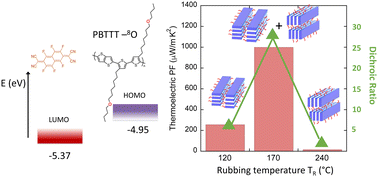Optimizing chain alignment and preserving the pristine structure of single-ether based PBTTT helps improve thermoelectric properties in sequentially doped thin films†
Abstract
Doped polymer semiconductors are of central interest in material science for their interesting charge transport and thermoelectric properties. Polymer alignment and crystallization are two means to enhance thermoelectric parameters (charge conductivity σ and Seebeck coefficient S) in the polymer chain direction. In this study, we focus on the thermoelectric properties of a PBTTT polymer semiconductor bearing linear heptyl-oxy-butyl (C7OC4) side chains (PBTTT-8O) in thin oriented films aligned by high-temperature rubbing. Both the degree of in-plane orientation and the preferential contact plane of the polymer are determined by the rubbing temperature that can be tuned in a large 25–240 °C range. Optimal TE properties with high charge conductivities in the 2–5 × 104 S cm−1 range and power factors >2.0 mW m−1 K−2 are obtained in the chain direction only when the film orientation is optimized (dichroic ratio >20). Contrary to other dopants such as FeCl3, the structure of PBTTT-8O is little modified by the inclusion of F6TCNNQ dopant molecules in the layers of disordered side chains. UV-vis-NIR spectroscopy shows that dimer formation of the radical anion F6TCNNQ˙− explains this behavior. Overall, this study demonstrates that the highest thermoelectric performances for a given polymer/dopant system can only be uncovered when the optimal conditions for polymer semiconductor growth/alignment and sequential doping are found. In addition, the S–σ scaling laws along and perpendicular to the chain direction are (i) independent of the chemical nature of side chains and dopants and (ii) essentially determined by the level of chain alignment and molecular packing of PBTTT backbones.



 Please wait while we load your content...
Please wait while we load your content...